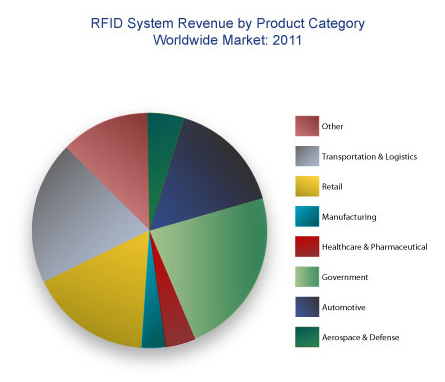The RFID market and location technologies, in general, have been a favorite of mine to watch as I think they have a huge unrealized potential. I actually thought that RFID (and M2M communications) would take off a couple of years ago but they have been slow to catch on. But that seems to be changing recently as projections of the next few years have been very positive.
ABI Research recently reported the market for RFID transponders, readers, software, and services will generate $70.5 billion from 2012 to the end of 2017. The market was boosted by a growth of $900 million in 2011 and the market is expected to grow 20% YOY per annum. Government, retail, and transportation and logistics have been identified as the most valuable sectors, accounting for 60% of accumulated revenue over the next five years.

Group director John Devlin comments, “To date, the automotive sector has been a strong proponent of RFID, largely for immobilization and keyless entry. However, penetration is already high and it will be constrained by the slower rise in automotive production volumes. As a result, it will lose status as a leading RFID market due to other established markets for RFID retaining excellent potential for further adoption. Retail in particular is set to experience very strong growth; in fact, it will become the single largest RFID sector in 2015.”
Efficiency and improved operational capability are the overriding goals behind this adoption. Retail growth is driven by the proven returns that item level tagging can deliver. Stock is less likely to get lost, shop floors better stocked, and the ordering process will get smarter. RFID will cross over into customer-facing services with NFC for product information and smart marketing.
Government is a high-value sector, with strong uptake of contactless/RFID in documents and credentials. However, the drive for increased efficiency in applications such as asset tracking, fleet management, personnel location, and security are increasing the sector’s acceptance and uptake of RFID solutions.
Transportation and logistics increasingly make use of the ability to accurately track and trace items and goods at item, pallet, and container level as service providers look to generate more detailed data for themselves and their customers. Also, smarter public transit systems are utilizing contactless ticketing as the basis for better managed and cost effective services.

